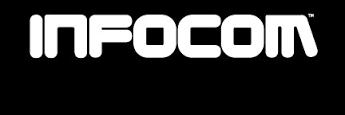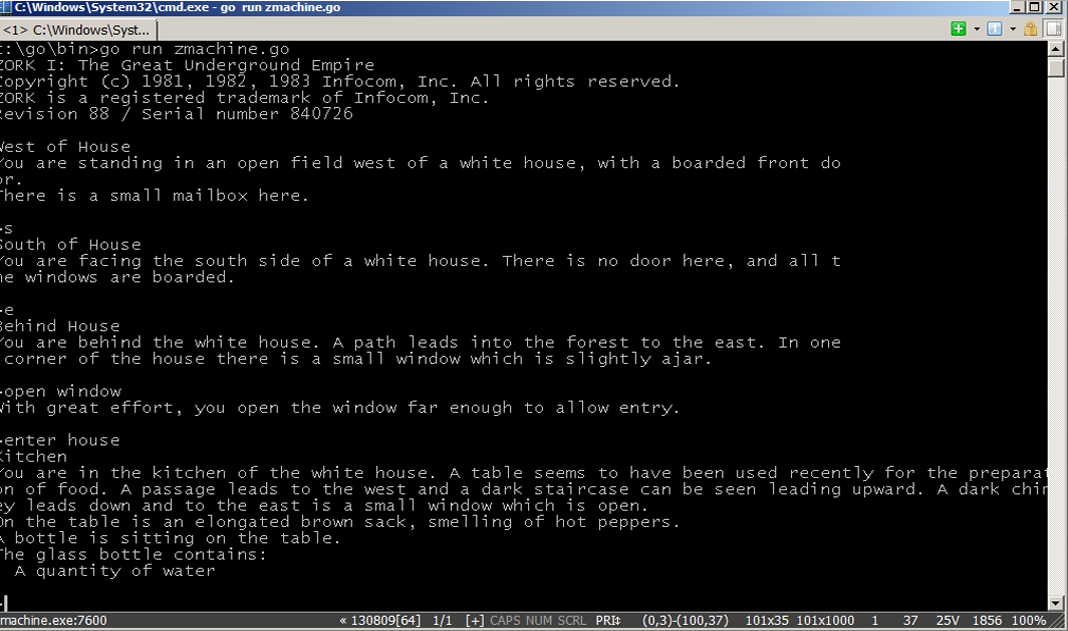Infocom
Infocom was a software company, based in Cambridge, Massachusetts, that produced numerous works of interactive fiction. They also developed one notable business application, a relational database called Cornerstone.
In 1972 Colossal Cave (also known as Adventure), a text-based game in which you had to collect treasures in a gigantic cave, was written by a man named Willie Crowther, who put it on the university mainframe at Boston University. It was rudimentary and lurked around there, until in 1976 it was immensely expanded by another unselfish human being, Don Woods. This improved version became highly popular among college students, who played it by accessing the mainframe over ARPAnet (the ancestor of what today is the Internet). Two of those, sometime early in 1977, that couldn't stop playing were Dave Lebling and his friend Marc Blank from the Massachusetts Institute of Technology, or MIT for short. Both were part of MIT's Laboratory for Computer Science (LCS), which at that time created a programming language called MDL.
Blank, Lebling, Anderson, and yet another student, Bruce Daniels, started with the real project. They designed maps and puzzles for players to solve and named this new endeavor Zork - a hacker world floating around at that time, which the for actually used on all their works-in-progress. Later it was decided to change the name to Dungeon, but, to avoid copyright problems, the much more original name Zork was kept.
In 1980 Infocom released Zork I, and later most of the famous features like the Great Underground Empire, ruled by Lord Dimwit Flathead the Excessive and the feared Grue, which Lebling had borrowed by Jack Vance, were already in it.
On the university's PDP-10 the game was a gigantic success and massively distributed over ARPAnet. Hundreds of users got hooked on it and the team received a never ending line of comments which they used to still enhance the game and make puzzles better. It was until 1979 when the guys actually put the last puzzle into it (a last mainframe update was done in 1981) and by that time this mainframe version of "Zork" had reached the size of about 1 Megabyte - a huge size back then.
Originally they had planned to let the case rest once the game got finished, as they had achieved their goal: to do a better game than Colossal Cave. But just at that time a number of people at LCS decided to form a company, because they wanted to stay and work together after graduation from MIT.
They didn't have the slightest idea what they wanted to sell, but with Lebling and Anderson being two of the possible founders, they decided to use what is already there and make Zork their first product - it was never intended that this company would specialize on entertainment software.
Meanwhile and independently Joel Berez, who at that time was working on his graduate studies at LCS and had heard about the Zork project, and Marc Blank, who was trying to realize the wish of his parents to become a doctor, met by chance in Pittsburgh. Together they marveled about the exciting success of the newly available home computers, among them the TRS-80 and the Apple II, who had the capabilities to process more complex tasks than the machines before.
Just as an intellectual challenge, they tried to find a way that would allow to bring Zork, which was programmed to work on a large mainframe, to these computers and came up with a genius system to do so. They designed a special programming language, which through an emulator could run on any computer and called it Z-Machine. It was a virtual processor, which ran on the newly compiled ZIL (Zork Implementation Language) while every home computer got its own ZIP (Z-Machine Interpreter Program), that could interpretate the Z-Machine code for it.
Having the solution for the problem that the LCS group faced, Blank and Berez became part of the new company, that after a lot of discussion was named Infocom and officially founded on June 22, 1979 by Tim Anderson, Joel Berez, Marc Blank, Mike Broos, Scott Cutler, Stu Galley, Dave Lebling, J. C. R. Licklider, Chris Reeve and Al Vezza. The first Board of Directors consisted of Berez, Broos, Galley, Lebling, and Vezza.
Problem was, Zork was still too big for the Apples and TRS-80s, which had 16KB of memory. They were forced to take huge bits out of the original and named the revamped game Zork I. Finally, after some more bug huntings and improvements, Infocom in 1980 had its first official product to sell, got its own P.O. Box and looked for a distributor. In November 1980 Zork I was out for the PDP-11. In 1981, Bruce Daniels, already working for Apple, also adapted it for the Apple II. In 1981 Infocom released Zork II.
But, unfortunately, not much later in the same year and when Infocom was still on the rise to be one of the brightest stars of the software industry, the company already made its worst decision: go back to the initial intentions when founding the company, like have a business division and do a program called Cornerstone, a database. Loads of money were coming in and loads of money were spent on that one project (too much). Cornerstone was finished in 1984 and published in 1985.
With that luggage to carry Infocom also had to face another problem: In the mid-1980s faster computers with faster processors and better graphical qualities were introduced and players shifted their preferences to games with graphics, animations and sound. The market for text adventures became more limited and that didn't help to get rid of the financial burden.
Infocom's fitness was failing and finally only one step was left: To cope with the changing market, bad financial shape and to let the company survive Infocom was sold on June 13, 1986 to the pioneers of the Atari VCS, Activision, for about 7.5 million Dollars.
Still, even after being bought by Activision, Infocom had problems and to get along with the market changes was forced to make concessions. So in 1987, Beyond Zork, written by Brian Moriarty, became the first Infocom game to feature a graphical user interface. It had a map that changed according to the player's movements among other graphic tidbits and also had some roleplaying elements. To take this development even further, Zork Zero, written a year later by Steve Meretzky, came with even more enhanced graphics. But hardcore fans got alienated by the graphics and new buyers couldn't be attracted. Infocom still wrote great adventures, but did not have enough experience in doing graphical games. Infocom officially failed on May 5, 1989.
For a few years, Activision continued to market Infocom's classic games in collections; In 1991, they published The Lost Treasures of Infocom, followed in 1992 by The Lost Treasures of Infocom II.

